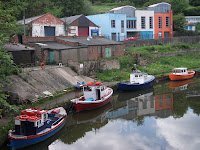Food has played a prominent part in the sites we've visited on this trip. Hardly a museum is without its own cafe; even the smallest usually have a tea room. Gift shops, too, regularly include edibles (often locally-produced) in the form of ice cream, chocolates, and jams. Castle Howard had its own small grocery store full of goods from its tenant farms and surrounding areas.
A nearby creamery supplied this themed snack to Housesteads Roman Fort on Hadrian's Wall.
I was prepared to see representations of food in the exhibits. Eating is, after all, one of the things that every visitor has in common with every person in the past. For museums striving to cultivate that sort of personal connection, talking about diets and dining is a common route. Those topics also benefit from natural connections to common collection objects like dishes and utensils.
I was less prepared to see real food in the exhibits. This was my favorite way to encounter it (especially when visitors were allowed to taste!). At Beamish Open Air Museum, costumed interpreters shared the fruits of their demonstrations in historic kitchens. Some were for sale (as in the chocolatier's shop) but others went straight from cast-iron oven to visitor for free. We encountered a similar situation in the “below stairs” area of Harewood House, but the docent there brought in her shortbread from a modern kitchen (she said health and safety regulations restricted use of the old stove). At both sites the food is meant to enrich the visitor's experience by engaging the senses of smell and taste. Both are usually lacking in a classic “sterile” museum environment, but noses and tastebuds are getting more exercise as such techniques become increasingly common in museums.
Bakers in Beamish's mining village making cookies before sharing a different batch with eager onlookers. (Photo courtesy of Rebecca Bush)






.jpg)





.jpg)




















 What better way to marry the enthusiasm of the impending World Cup with brash commercialism (and maybe start an international food fight) than to dream up irresistible / disgusting snacks?
What better way to marry the enthusiasm of the impending World Cup with brash commercialism (and maybe start an international food fight) than to dream up irresistible / disgusting snacks?




